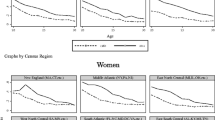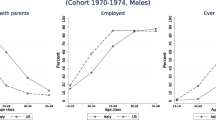Abstract
The timing with which young people leave their parents' home is a critical element in household formation rates. Direct data on this transition are scarce. Information on the current living arrangements of 16–24 year-olds collected in a 1982 EEC Survey provides some insights. The data suggest quite large cross-national variations in the timing of leaving home and particularly marked differences in the living arrangements of young people. Reasons for the variation, particularly housing-market differences, are postulated.
Résumé
L'âge auquel les enfants quittent le foyer de leurs parents est un élément essentiel du processus de formation des ménages. Les données portant directement sur cette transition sont rares. Les renseignements sur la situation familiale des jeunes de 16 à 24 ans, recueillis par une enquête de la Commission des Communautés Européennes en 1982, fournissent quelques aperçus. Ils indiquent de très grands écarts entre pays quant à l'âge auquel les enfants partent, et des différences particulièrement marquées quant à la nouvelle situation familiale des jeunes. L'auteur suggère quelques explications de ces différences, comme le rôle du marché du logement.
Similar content being viewed by others
References
Brown, A. and K.E. Kiernan, 1981, Cohabitation in Great Britain: Evidence from the General Household Survey, Population Trends 25.
Commission of the European Communities, 1982, The young Europeans: An exploratory study of 15–24 year olds in EEC countries.
Dunnell, K., 1979, Family formation 1976 (Her Majesty's Stationery Office, London).
Festy, P., 1985, Evolution contemporaine du mode de formation des familles en Europe occidentale, European Journal of Population 1, no. 2/3, 179–205.
Glick, P., 1957, American families (Wiley, New York).
Glick, P., 1977, Updating the life cycle of the family, Journal of Marriage and the Family 39, no. 1, 5–13.
Hajnal, J., 1982, Household formation patterns in historical perspective, Population and Development Review 8, no. 3, 449–494.
Haywood, I., 1984, Housing in Denmark, in: Wynn (1984).
Höpflinger, F., 1984, New developments of family formation in Europe, Mimeo. (Centre for Population Studies, London).
Kennedy, D., 1984, Housing in West Germany, in: Wynn (1984).
Kiernan, K.E., 1985, The departure of children: The timing of leaving home in the life-cycles of parents and children, Paper presented at an IUSSP/DGBW seminar on: The later phases of the family life cycle, West Berlin, Sept., 1984, Research paper no.85-3 (Centre for Population Studies, London).
Modell, J. and T. Hareven, 1973, Urbanisation and the malleable household: An examination of boarding and lodging in American families, Journal of Marriage and the Family 35, no. 3, 467–479.
Roussel, L. and P. Festy, 1979, Recent trends in attitudes and behaviour affecting the family in Council of Europe member states (Council of Europe, Population Studies no. 4, Strasbourg).
Schwarz, K., 1983, Les ménages en République Fédérale d'Allemagne: 1961–1972–1981, Population 38, no. 3, 565–584.
UNESCO, 1982, Statistical year book.
Wynn, M., ed., 1984, Housing in Europe (Croom Helm, London).
Young, C., 1977, The family life cycle: Literature review and studies of families in Melbourne, Australia, Australian Family Formation Project, Monograph no. 6 (Department of Demography, Australian National University, Canberra).
Young, C., 1983, Leaving home and returning home: A study of young adults in Australia, Paper presented at the Institute of Family Studies, Australian Family Research Conference, Canberra, Nov. 1983.
Young, C., 1984, The effect of children returning home on the precision of the timing of the leaving home state of the family life cycle, Paper presented at an IUSSP/DGBW seminar on: The later phases of the family life cycle, West Berlin, Sept., 1984.
Author information
Authors and Affiliations
Additional information
Acknowledgements: Thanks are due to the Economic and Social Research Council for financial support (this paper was prepared at the Centre for Population Studies, LSHTM, which is a Designated Research Centre of the ESRC), the ESRC data archive at Essex University for providing a copy of Eurobarometer 17, and the Commission of the European Communities for making the data available for further analyses. Sole responsibility for this study lies with the author. The helpful advice of the editor is gratefully acknowledged.
Rights and permissions
About this article
Cite this article
Kiernan, K. Leaving home: Living arrangements of young people in six west-European countries. Eur J Population 2, 177–184 (1986). https://doi.org/10.1007/BF01796889
Received:
Revised:
Issue Date:
DOI: https://doi.org/10.1007/BF01796889




